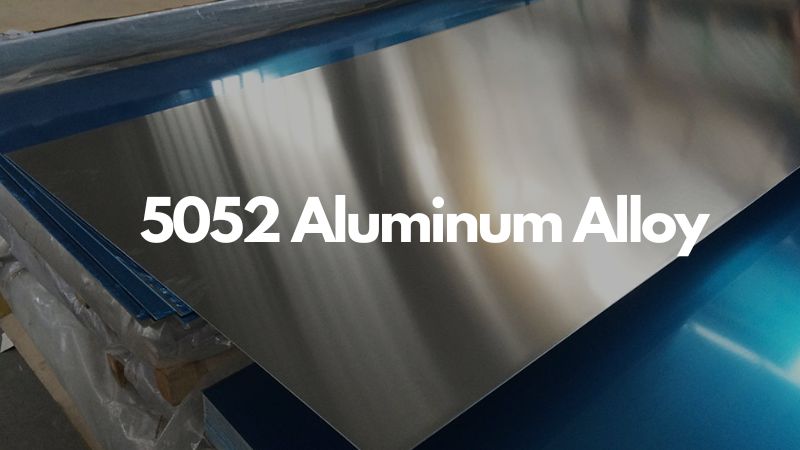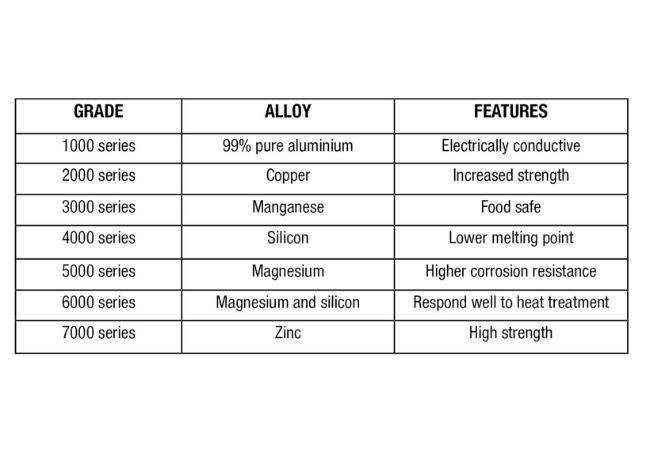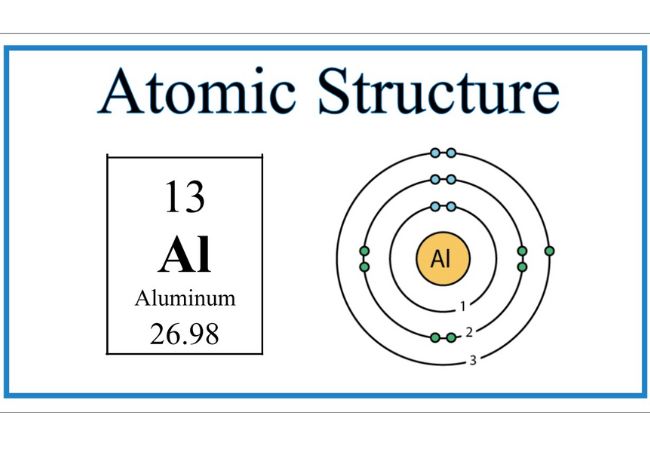
In this article, you will learn about alloy 5052 and how it compartes to the other alloys. From chemical composition, features, applications to properties – all information you are looking for is right here.
What is 5052 Aluminum Alloy?
5052 is an aluminum alloy made up of magnesium and chromium. These are the main alloying elements alongside other chemical composition.

Advantages of Aluminum Alloy 5052?
When it comes to certain specialized applications, you should consider aluminum alloy grade 5052. This basically due to:
- It has perfect weldability
You can use several techniques to weld this alloy easily with no difficulties. You can use many aluminum welding techniques to this grade such as metal inert gas welding, and tungsten inert gas welding, among many others.
- Corrosion resistance is another primary advantage
Thus, it is suitable for marine atmospheres because of salty water.
- Its strength is also one advantage
Alloy 5052 might not be one of the strongest aluminum alloys, but it is strong enough and durable. Hence, it is possible to use it in several applications.
- It has good formability
You can easily make it into different shapes without cracking or breaking it. This property makes it suitable for multiple applications. These include construction and automotive application.
- The alloy is easy to machine
You don’t require complex tools and accessories to machine this aluminum alloy. It is most suitable for parts that are hard and components. Ideally, you can fabricate aluminum alloy to make any part of your choice.
Chemical Composition of Type 5052 Aluminum
Among the key elements are:
- Magnesium –It forms a large percentage by weight in this aluminum grade. It makes up 2.5% of the aluminum 5052. You can add it to improve your strength. This makes it best for applications that require high tensile strength.
- Iron -A trace element with a composition of about 0.40%. It is a common impurity found in aluminum alloys. However, it does not have any significant effect on alloy properties.
- Copper -This is a trace element with a composition of approximately 0.1%. You can add it to improve the conductivity and strength of the alloy.
- Silicon -It has a composition of around 0.25%. It improves the casting properties of the alloy when you add it.
- Aluminum; this is the primary element in the alloy. It comprises almost 95.7% of aluminum 5052.
- Titanium – it has a composition close to 0.15%.
- Manganese -An element of aluminum 5052 with a composition of 0.10%. Its presence increases the strength and workability of the alloy.
- Zinc – usually, it has a composition of approximately 0.10%. When you add it, it improves the corrosion resistance of the alloy.
- Chromium – this is also a minor element with a composition of about 0.25%. Its addition increases the corrosion resistance of the alloy.
Alu 5052 Mechanical Properties

Again, before choosing this Alu grade for any applications, you should evaluate its strength. Among the key properties to evaluate are;
- Fatigue strength – the alloy is known for excellent fatigue strength. The alloy can withstand repeated stress cycles without breaking.
- Elastic modulus – alloy 5052 has an elastic modulus of 70 GPA. It has a high measure of stiffness. That also shows how much it will deform under a given load.
- Tensile strength – its tensile strength of between 210 and 260 MPa. It can therefore withstand a lot of pressure and stress without deforming or breaking.
- Hardness – its hardness is within the range of 60 to 80 on a scale.
- Yield strength – aluminum 5052 has a yield strength of between 130 and 180MPa. This is the amount of stress the alloy can withstand without deforming or even breaking completely.
- Elongation-The elongation at break for aluminum 5052 is between 12% and 25%
Physical Properties of 5052 Alu Alloy
Here are some of the physical properties of aluminum alloy 5052;
- Electrical conductivity– aluminum alloy has an electrical conductivity of around 58-62% of copper conductivity. This means it conducts electricity well. For applications where electrical conductivity is a requirement, it is the best option.
- Melting point – alloy 5052 has a melting point of about 607-649 degrees celsius. This makes it the best option for applications that require different shapes. You can melt it and form several shapes with the melted alloy.
- Coefficient of thermal expansion – this type of alloy expands and contracts moderately with temperature changes. This is a very important factor to consider in some applications.
- Density – when it comes to density, it is lighter compared to other aluminum alloys. This makes it suitable for applications that require lightweight materials.
- Magnetic properties – aluminum 5052 is not magnetic at all. you should therefore use this in applications that do not require magnetic interference.
- Thermal conductivity – this alloy is an excellent conductor of heat. It has a thermal conductivity of about 138-170 w/mk. It is therefore useful in applications that include heat.
Comparing 5052 Aluminum and 6061 Aluminum
- The primary alloying element of aluminum 5052 is magnesium while the primary alloying elements of Aluminum 6061 are magnesium and silicon.
- Aluminum 5052 also contains manganese, iron, and copper whereas Aluminum 6061 also contains titanium, manganese, and iron in small amounts.
- When it comes to higher strength, the 6061 is a better options compared to the 5052 series.
- Aluminum 5052 is more resistant to saltwater corrosion. This makes it the best for application in the marine.
- Although aluminum 5052 and aluminum 6061 are both easily weldable, aluminum 6061 requires heating to be done before. Preheating is done to prevent cracking.
- The machinability of aluminum 6061 is higher than that of aluminum 5052. It is easier for it to make machines because of its chip formation.
- The price of aluminum 5052 is less than the price of aluminum 6061 because it has fewer composition of alloying elements.
- Aluminum 5052 is more formable than aluminum 6061. This makes it easier in instances where metals need to be created in other shapes.
- Aluminum 6061 is most suitable for structural and engineering applications. On the other hand, aluminum 5052 is most suitable for marine applications.
- Aluminum 5052 has a smooth surface while Aluminum 6061 has a semi-smooth surface.
- Aluminum 5052 is not heat treated unlike Aluminum 6061 which is heat treatable.
- Aluminum 6061 has a semi-smooth surface while aluminum 5052 has a smooth surface.

Forms Aluminum 5052 Exists
- 5052 aluminum sheet-A flat and thin piece of aluminum with a smooth surface. It is applicable in various fields. These fields include building materials, electronic components, and automotive parts.
- 5052 aluminum rod-It is a cylindrical bar made of aluminum metal. The areas it is applicable are manufacturing, construction, and engineering. This is because they are strong and durable.
- 5052 aluminum coil-An aluminum piece that is long, thin, and continuous that is wound into a coil. It is rolled through a series of rollers to achieve the target thickness. Applicable in making gutters, cans, and roofing materials.
- 5052 aluminum tube-It is cylindrical and typically used for packaging. They are preferred over plastics because of their eco-friendly nature. The tubes can be printed and sealed at one end or both with crimps.
- 5052 aluminum plate-This is a thicker, flat piece of aluminum that is lightweight and durable. It is used in solar reflective plates, signs and nameplates, and structural applications in the marine.
Surface Finishing on Aluminum 5052

- Anodizing–Process that consists of creating an oxide on an aluminum surface. The layer it creates can help with corrosion resistance and increase surface hardness.
In addition, it can provide a base for further decorative coatings.
- Painting-Used for both protective and decorative finishes on aluminum 5052. There are steps to painting such as cleaning the surface for good adhesion. Primers used in painting aid in improving corrosion existence.
- Polishing-Creates a smooth, reflective finish on the surface. It can be done mechanically or chemically. Finishing can range from a satin to a mirror-like shine.
- Brushing – process of creating a series of parallel lines on aluminum 5052 surfaces.
It involves using abrasive materials like sandpaper. Chemical brushing involves treating the aluminum surface with a chemical solution.
- Powder coating-Involves spraying a dry powder on the surface. It is further heated to fuse the powder and create a durable coating. This helps increase corrosion resistance.
Applications of Aluminum Alloy 5052
There are many practical applications where you can use 5052 grade aluminum such as:
- Sea water pipes and aluminum panels
- Ship building and boats construction
- Roofing systems
- Electrical and electronics parts including enclosure systems
- Storage systems such as pressure tanks
- Food and beverage systems
- Automobile body panels, wheels fuels tanks, etc.
- Cooking utensils and appliances
- Trailer siding systems
- Lighting systems
- Heat exchanger parts and components
5052 Aluminum Alloy Specification
Aluminum alloy 5052 contains nominally 2.5% magnesium, 0.25% chromium.
Conclusion
Clearly, 5052 aluminum plays an integral role in modern sheet metal fabrication industries. With the information in this guide, it is easier to decide whether 5052 grade aluminum is best for your applications or not.
More Resources:
Aluminum 5052 Alloy – Source: Wikipedia
About 5052 Grade Aluminum – Source: Thomas Net
Aluminum 5052 – Source: Mat Web
UNS A95052 – Source: Azo Materials




